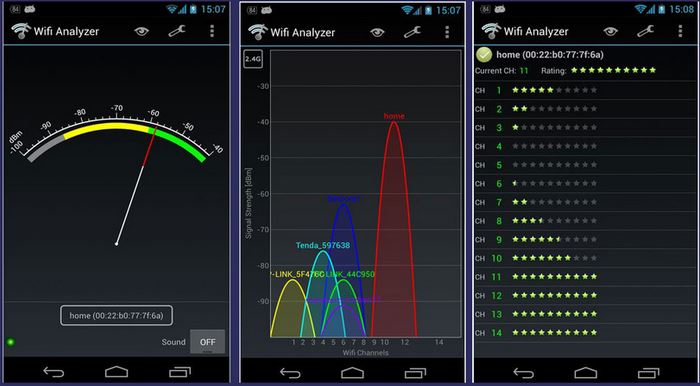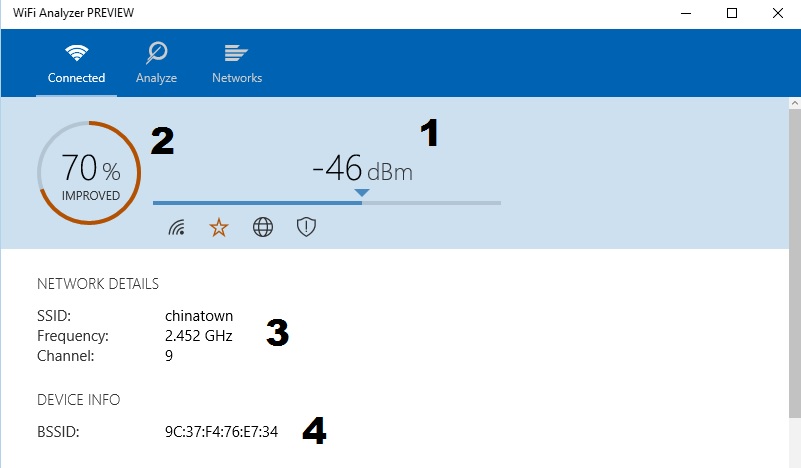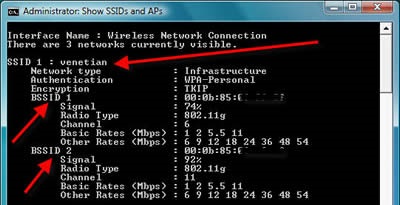It is often necessary to quickly check the level WiFi signal to select the most free channel with good quality reception. For this task, it is impossible better fit simple android app Wifi Analyzer.
With its help, you can easily not only determine free channels, but also check the quality wi-Fi reception in different locations apartments or cafes or view the signal changes over time. After starting, a graph will be visible in the main window of the program, which will display the visible wireless networks, the reception level and the channels on which they work. If they intersect on the chart, this will be clearly displayed.

You can also see the "rating" of the channels, by the type of any star ratings, which clearly shows how appropriate the choice of one or another of them is at the moment. Another feature of the application is force analysis wi-Fi signal... First you need to choose for which wireless network a check is made, after which you can watch the reception level, while nothing prevents you from moving around the area or checking the change in reception quality depending on the location of the router.
It would also not be superfluous to add that our interest in WiFi networks maybe not only in passive analysis. With help mobile phone you can also try to guess the password for the wireless hotspot. For this you need an application called WIBR.
WIBR is a unique application with which you can hack Wi-Fi neighbor and use its internet for free. This is not a joke, WIBR works on the principle of automatic selection of passwords (brute) to Wi Fi, and if the password is simple, then the probability of guessing the password is close to 100 percent.

Vibr supports cracking several Wi-Fi networks at once, and shows information on one screen, when you click on one of the networks, you can see detailed statistics about the progress of work: the number of passwords per minute, how many password options have already been verified and how many are left.

The application supports downloading your own dictionaries, for this you need to download them (or write all the options yourself in a notepad) possible passwords and save in txt format), specify the path in the program itself. Especially for our users, we have added more than 10 dictionaries with the most common passwords.
About the choice wi-Fi channel quite a few articles and detailed manuals have already been written. The bottom line is always the same - the freer the channel, the more stable, stronger and more stable the signal. For Windows 10, a preview version of the most popular utility for fast monitoring of radio channels, WiFi Analyzer, has finally been released. Now it's easy to find out the free range
The Windows version assumes that you already have Windows 10 on board, so you need to update. On phones running Windows Phone the utility will not get up for the same reason - you need a "dozen", but since it has not come out yet, you can install it only on personal computers.
External factors have a huge impact on the signal. Walls, electrical appliances, other Wi-Fi networks. Even the material of your interior door can play a big role in the channel capacity. Them detailed description can be found at http://optim-yug.ru/. You can also ask the price there and choose a good interior door for yourself.
Download WiFi Analyzer for Windows 10
https://www.microsoft.com/ru-ru/store/apps/wifi-analyzer-preview/9nblggh33n0nHow to use?
When you start the program, a window opens:

1 - Receiver sensitivity.For my adapter, it is 46 dBm (decibel-milliwatts). Sensitivity, in this aspect Is the minimum signal level at which Wi-Fi will work. The closer you are to the access point (router), the lower the sensitivity. The further, the more the receiver needs to "plow" in order to correctly process the signal. A value greater than -85 dBm is considered unsatisfactory for normal operation.
If any of the icons are lit, then:

2 - Signal quality
3 - Basic network parameters. Here we will see the name (SSID) of the network to which we are connected, the frequency and the current channel.
4 — BSSID - The MAC address of our wireless network.
Separately about BSSID - what is it?
Basic service set identification (BSSID) -a unique number (mac-address) of our wireless network. If your router supports MBSSID technology, then you can configure up to several access points on one router. Those. multiple networks within one Wi-Fi network. One SSID can have up to four BSSIDs, respectively, each will have its own MAC address. You can see it in command line team netsh wlan show networks mode \u003d bssid ... This is how it looks:

What is it for? For different security policies (guest network / staff network), different routing policies (static IP, DHCP) and so on. Yes, you can buy a second access point and configure everything there, but this is additional financial costs + an extra device on the network.
How to choose the right channel?
Go to the "Analyze" tab at the top of the program and see the following picture:

Each arc is someone's Wi-Fi network, respectively, on the left is the sensitivity of the sensor (signal level), at the bottom - channels. Thus, you can track on which of the channels the greatest number of access points "graze". To make it clearer, try turning on the display of the SSID. This makes the picture even clearer:
![]()
Please note that the program itself recommends which channel is most beneficial for our laptop / pc:

Thus, we found out the most "noisy" broadcast, looked at the sensitivity of the receiver and found out that the freest radio channel for our device is 12
What else can you do?
If the signal between the router and the laptop still leaves much to be desired, and the distance between them is very small (1-3 meters), then it is recommended to remove the router from the walls in order to eliminate interference from neighboring devices (this may not necessarily be a router). Try to put the router at different points of your apartment - even minor movements around the room can give up to 90% (!) Improvement in the signal and, accordingly, the speed over the Wi-Fi connection
Chip's opinion: Google promises a simple solution to maximize WLAN coverage in every home. Using the system Google wifi The internet giant manages to really improve its hardware. The system is very easy to set up and offers high performance even in the most remote corners of the apartment.
You can get Google WiFi with one, two or three "units" - the number depends on the size of your home. In the case of the kit we tested, we are talking about two "units" of Google WiFi, which together should provide full WLAN signal coverage of an apartment of up to 100 square meters.
Compact and powerful
Dressed in white plastic clothes google system WiFi thanks to a quad-core processor and 512MB random access memory has a large enough power. At the same time, four antennas are built into Google WiFi - two for the 2.4- and two for 5-GHz band. According to the manufacturer, the system is capable of operating simultaneously in two bands and thus, in theory, maximum speed data transmission up to 1200 Mbit / s.
With Beamforming technology, the transmitter power can be further increased. In addition, two Gigabit ports can be used for LAN or WAN connections. Google WiFi uses WPA2-PSK as the encryption method, which is a modern standard.
Google WiFi: expands according to apartment size
All through the app
Setting up a WLAN system from google made exclusively through the application (Google WiFi), which is installed on a smartphone or tablet. At the same time, all user configuration actions are accompanied by a really good assistant. Even without his prompts, you must first connect one of the Google WiFi “units” to an electrical outlet and your Internet connection (an existing modem-router or modem) - it will not be available through the integrated Google WiFi modem.
Then you should launch the setup application on your smartphone with the assistant. The app will find your Google WiFi "primary unit" via Bluetooth. Then use the camera to scan the QR code located on the back of the Google WiFi, and then the WLAN connection should be established.
Now you give your network a name, then set a password to connect to it - and you're done! Adding a second “unit” is as simple as plugging it into an outlet, keeping your smartphone with Bluetooth enabled for a while, scanning the QR code - and you're done too!
 Something more, something less: the Google WiFi app won't share a lot of information
Something more, something less: the Google WiFi app won't share a lot of information You Can't Do Much
The application does not offer a really large number of options for customization. You can prioritize specific user requests, create a guest network, add new Google WiFi devices, test your internet connection speed, and use a couple more features.
Moreover, it is the connection tests that show "heterogeneous" results: if a pure test of the Internet connection speed (measured by the LAN port of the primary "unit") gives the result in "real" numbers, then the quality of communication between individual "units" of the system is assessed by the application only by school marks ...
Everything is displayed clearly, intuitively, and graphically designed accordingly. But all this is not for those users who are engaged in network settings at a professional level! In particular, it will be in vain to look for the ability to manually set WLAN channels or change other settings in the network.
The best WLAN everywhere!
In everyday use, you really won't notice when your device "swaps" one Google WiFi "unit" for another - in this sense, the network is completely homogeneous. So in our test apartment, we could not find a single "bottleneck" that previously met in one or another corner - the system invisibly and constantly connects you to the time you need at a given moment google device WiFi.
Now the signal level is really very good everywhere, which is noted not only by subjective feelings, but also by the measurement results. google apps WiFi. Perhaps, automatic selection canals functions very well here.
Alternative: More Power - Netgear ORBI AC3000 (RBK50-100PES)
Netgear also promises the best WLAN coverage in all corners of your apartment or your home with its WLAN system, which costs about 27,000 rubles. Based on the results of the practical test, we can confirm that it works really well. At the same time, setting up the Orbi system is also very simple.






